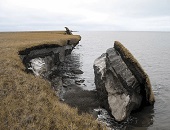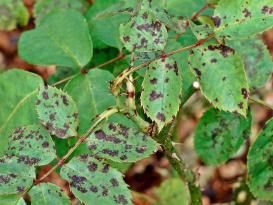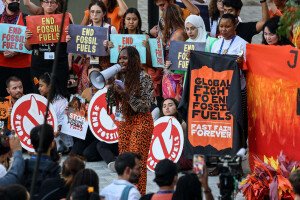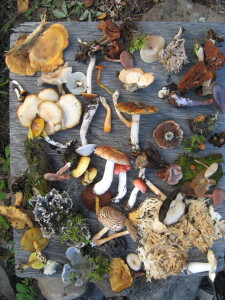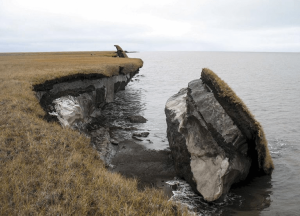As 2023 draws to a close, we see increasingly severe climate outcomes around the world—from rising emissions to severe weather events, to increased food and water inequality.
 Three days before the United Nations Climate Change Conference COP 28 began, a multidisciplinary research organization welcomed scientific panellists to a webinar for an audience of hundreds on November 27, 2023, titled “Nurturing a Resilient Earth.”
Three days before the United Nations Climate Change Conference COP 28 began, a multidisciplinary research organization welcomed scientific panellists to a webinar for an audience of hundreds on November 27, 2023, titled “Nurturing a Resilient Earth.”
The virtual event, sponsored by CIFAR (Canadian Institute for Advanced Research), convened an interdisciplinary panel of four top researchers. The discussion was moderated by Stephen Toope, President & CEO of CIFAR, and the author most recently of A Rule of Law for Our New Age of Anxiety. He had a series of questions to pose to the researchers, to highlight some of the researchers’ novel approaches to tackling climate change.
What role can an interdisciplinary body such as CIFAR play in addressing climate change?
 “The fungal kingdom is moving in tandem with climate change,” said Sarah Gurr, Chair in Food Security at University of Exeter. Interdisciplinary ideas within the fungal community are already addressing the problems. She was appointed Fellow, Fungal Kingdom: Threats & Opportunities, at CIFAR. Her interest is in plant disease, with particular emphasis on fungal infestations and their global movement and control. She has modelled movement, assessed global burden, and commented on the impact of climate change on pathogen spread.
“The fungal kingdom is moving in tandem with climate change,” said Sarah Gurr, Chair in Food Security at University of Exeter. Interdisciplinary ideas within the fungal community are already addressing the problems. She was appointed Fellow, Fungal Kingdom: Threats & Opportunities, at CIFAR. Her interest is in plant disease, with particular emphasis on fungal infestations and their global movement and control. She has modelled movement, assessed global burden, and commented on the impact of climate change on pathogen spread.
 “CIFAR enables us to pursue curiosity-driven research,” said Richard Taylor, Professor of Hydrogeology at University College London (UCL) and Adjunct Professor of Hydrogeology at Makerere University, Uganda. He was appointed Fellow, Earth 4D: Subsurface Science & Exploration, at CIFAR. His research examines the impacts of climate change including the amplification of climate extremes on groundwater systems. His research seeks to inform sustainable and equitable pathways to climate change adaptation and climate justice.
“CIFAR enables us to pursue curiosity-driven research,” said Richard Taylor, Professor of Hydrogeology at University College London (UCL) and Adjunct Professor of Hydrogeology at Makerere University, Uganda. He was appointed Fellow, Earth 4D: Subsurface Science & Exploration, at CIFAR. His research examines the impacts of climate change including the amplification of climate extremes on groundwater systems. His research seeks to inform sustainable and equitable pathways to climate change adaptation and climate justice.
What are some climate-related advances taking place in your field?
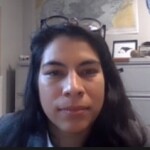 “Microorganisms are mediators of carbon systems. For example, the existence of methanotrophs was controversial,” said Jackie Goordial, an environmental microbiologist in the School of Environmental Sciences at University of Guelph. Methanotrophs are living creatures that metabolize methane, CH4, as their source of chemical energy. “But now we know they are consuming more methane than produced in the environment. We used to think methane was only produced in oxygen-deprived environments.” She was appointed CIFAR Azrieli Global Scholar, Earth 4D: Subsurface Science & Exploration.
“Microorganisms are mediators of carbon systems. For example, the existence of methanotrophs was controversial,” said Jackie Goordial, an environmental microbiologist in the School of Environmental Sciences at University of Guelph. Methanotrophs are living creatures that metabolize methane, CH4, as their source of chemical energy. “But now we know they are consuming more methane than produced in the environment. We used to think methane was only produced in oxygen-deprived environments.” She was appointed CIFAR Azrieli Global Scholar, Earth 4D: Subsurface Science & Exploration.
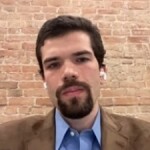 “We are looking into what role machine learning can play in climate change,” said David Rolnick, the Canada CIFAR AI Chair associate at the Quebec-based research institute Mila (originally Montreal Institute for Learning Algorithms) and an assistant professor in the School of Computer Science at McGill University. He is the co-founder and chair of Climate Change AI. Artificial intelligence is being used in a variety of ways, such as “satellite images of where floods are occurring, and to reduce waste in the energy grid.”
“We are looking into what role machine learning can play in climate change,” said David Rolnick, the Canada CIFAR AI Chair associate at the Quebec-based research institute Mila (originally Montreal Institute for Learning Algorithms) and an assistant professor in the School of Computer Science at McGill University. He is the co-founder and chair of Climate Change AI. Artificial intelligence is being used in a variety of ways, such as “satellite images of where floods are occurring, and to reduce waste in the energy grid.”
What makes it hard to address climate change?
“Getting research into practice is a major challenge,” Taylor said. As an example, he noted that climate change has greatly impacted the rainfall patterns in low-income tropical areas. “With these changes, how will we store water and reduce the likelihood of contamination of run-off?”
The public does not fully understand the threat posed by climate change. “People think the worst disease threats on the planet occur to humans,” said Gurr, “but widespread fungal disease of plants could be much worse, leading to mass starvation.”
Fungi are the main agents of crop disease. Ever since the Green Revolution of the 1970s, monocultures have become common. For example, “there’s a 14,000-hectare [54-square mile] grain farm in Alberta. One pathogen would have an immense feeding and breeding ground.” Since fungi have fast reproductive turnaround, they can quickly evolve to meet the conditions of the changing climate.
Do you feel hopeful that COP28 can address the problems of climate change?
“I don’t feel hopeful,” Rolnick said. “But climate change is not an on-off switch. Millions have already died—we get to choose how many.” It is necessary to “steer us toward one of the better pathways. “Making good policy and actions easier” is part of this. “Hard choices need to be made” and “machine learning can help” us make informed decisions.
“I feel a little more hopeful,” said Goordial, “because I focus on how the imperfectly executed things are getting improved” incrementally. “A lot of citizens are now asking politicians to take action” on climate change. “We have the potential to increase momentum.”
Setting research priorities is hard to do. When it comes to climate change, how can we all push in the same direction? Can research provide a shortcut to slow-moving policy?
“Push from science into policy,” Gurr suggested. An example is using gene editing to get plants better able to cope with hotter conditions. “CIFAR must shout with one voice to get more science education.”
Taylor said decisions related to climate change might have to be “taken out of the hands of politicians.” He noted, “There is a trend toward participatory research. We need an enabling environment—that will raise awareness.” The COP process is an example of public voices outside of COP being more progressive than what is going on inside. “There are very few people in the room who are actually listening to what is being said” during big meetings.
Research that is community-driven provides “greater opportunity for scientists to speak” through social media, said Goordial.
How does your research impact climate change?
Rolnick reminded the audience of the definition of artificial intelligence: “An AI system is a machine-based system that can, for a given set of human-defined objectives, make predictions, recommendations or decisions influencing real or virtual environments.” He noted that “a lot of AI is unflashy algorithms that distill data into useable information.” For example, in biodiversity monitoring, “we have biosensors in the field” collecting lots of data that “AI can process.”
Other examples of using AI are:
- to control and manage the electrical grid;
- to understand the carbon stock in forests;
- predicting crop yield based on conditions.
For the whole science of modelling and discovery, AI provides easier processing. “These applications are already in use today,” Rolnick said. “AI is already helping.”
“My research relates to the ‘carbon bomb’ that will happen as the permafrost melts,” Goordial said. Permafrost covers 50 percent of Canada and 27 percent of the world. As permafrost thaws, the microorganisms within it “will produce carbon dioxide and methane.” This will create a positive feedback loop for the carbon cycle, thereby accelerating carbon greenhouse gases. “We need to find a net methane sink so we can take this carbon out of the atmosphere.” It’s the kind of problem that machine learning could be applied to. There are different kinds of permafrost, with different patterns of response.
How can increased rainfall be both a blessing and a curse?
“There’s been a widespread transition to heavier rainfalls that increase the groundwater cycles,” Taylor said. There are also “increased frequency and duration of droughts.” These are not projections; these are the current reality. Understanding how the water balance changes is critical to understand drylands.
How will climate change affect food security?
Thanks to research on fungal threats, “we’ve been able to address individual diseases,” Gurr said. For example, scientists are able to inform governments where the next infestation will occur. Also, researchers have found that Madagascar should plant yams, not rice.
Food security issues require an interdisciplinary approach and the participation of stakeholders, said Taylor. It’s not just a hydrogeological problem, and we must not keep disadvantaging certain minorities. “We have to move beyond our disciplines” and work together. ♠️
The image of protest at COP28 is from Truthout.
The image of fungi in northern Saskatchewan is by Sasata – Own work, CC BY-SA 3.0.
The image of coastal erosion is By USGS – It is taken from a page on a NASA website and is attributed to USGS, Public Domain.

